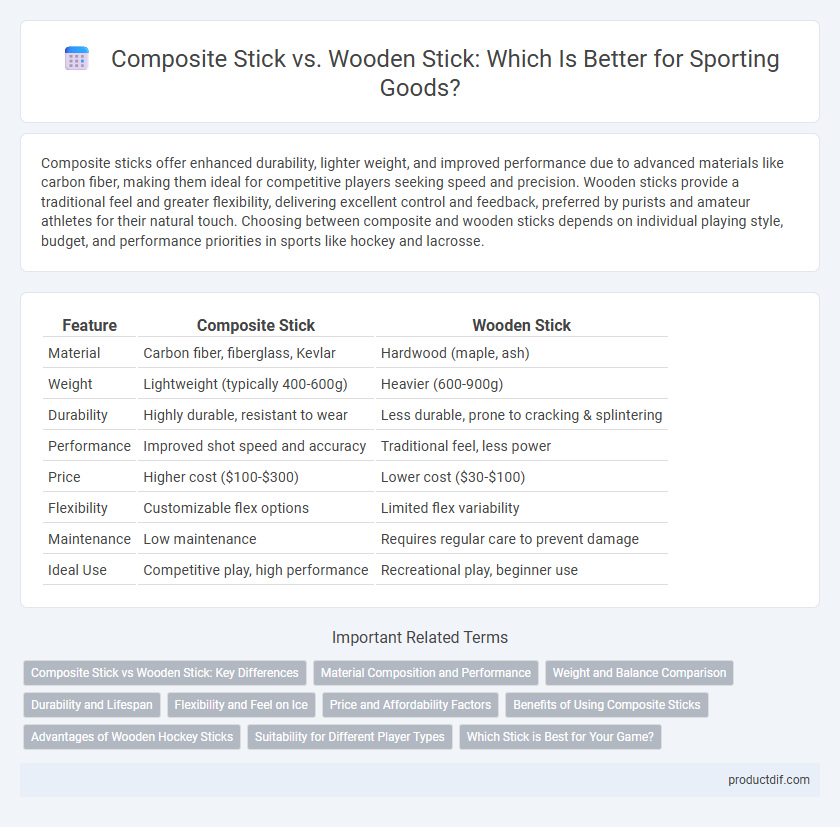Composite sticks offer enhanced durability, lighter weight, and improved performance due to advanced materials like carbon fiber, making them ideal for competitive players seeking speed and precision. Wooden sticks provide a traditional feel and greater flexibility, delivering excellent control and feedback, preferred by purists and amateur athletes for their natural touch. Choosing between composite and wooden sticks depends on individual playing style, budget, and performance priorities in sports like hockey and lacrosse.
Table of Comparison
| Feature | Composite Stick | Wooden Stick |
|---|---|---|
| Material | Carbon fiber, fiberglass, Kevlar | Hardwood (maple, ash) |
| Weight | Lightweight (typically 400-600g) | Heavier (600-900g) |
| Durability | Highly durable, resistant to wear | Less durable, prone to cracking & splintering |
| Performance | Improved shot speed and accuracy | Traditional feel, less power |
| Price | Higher cost ($100-$300) | Lower cost ($30-$100) |
| Flexibility | Customizable flex options | Limited flex variability |
| Maintenance | Low maintenance | Requires regular care to prevent damage |
| Ideal Use | Competitive play, high performance | Recreational play, beginner use |
Composite Stick vs Wooden Stick: Key Differences
Composite sticks offer enhanced durability and lighter weight compared to wooden sticks, making them a preferred choice for high-performance play. Wooden sticks provide a traditional feel and are often favored for their natural flex and lower cost. The advanced materials in composite sticks improve shot accuracy and power, whereas wooden sticks require more maintenance and are prone to damage.
Material Composition and Performance
Composite sticks are made from advanced materials such as carbon fiber, fiberglass, and Kevlar, providing lightweight durability and enhanced flexibility. Wooden sticks, crafted from hardwoods like ash or hickory, offer a traditional feel and natural flex but tend to be heavier and less resilient under stress. Composite materials improve shot power and accuracy by optimizing energy transfer, whereas wooden sticks often provide better tactile feedback but wear out more quickly.
Weight and Balance Comparison
Composite sticks offer significantly lighter weight than traditional wooden sticks, enhancing player speed and maneuverability. The balance in composite sticks is more customizable, allowing precise weight distribution that improves stick handling and shot accuracy. Wooden sticks tend to be heavier and have a less consistent balance, which can affect control and endurance during gameplay.
Durability and Lifespan
Composite sticks in sporting goods typically offer superior durability and a longer lifespan compared to wooden sticks due to their advanced materials like carbon fiber and fiberglass, which resist warping and cracking. Wooden sticks, while offering a traditional feel, are more prone to wear and damage from moisture and impact, leading to a shorter usable life. Athletes seeking longevity and consistent performance often prefer composite sticks for their enhanced strength and resilience.
Flexibility and Feel on Ice
Composite hockey sticks offer superior flexibility, allowing players to generate more powerful shots and quicker puck releases compared to wooden sticks. The advanced materials in composite sticks provide consistent flex points and enhanced energy transfer, resulting in improved performance on ice. Wooden sticks, however, offer a traditional feel and feedback that some players prefer for puck control and stickhandling precision.
Price and Affordability Factors
Composite sticks generally carry a higher price point compared to wooden sticks due to advanced materials and manufacturing processes. Wooden sticks remain more affordable, making them a popular choice for beginners and budget-conscious players. The increased durability and performance of composite sticks justify the investment for serious athletes despite the higher cost.
Benefits of Using Composite Sticks
Composite sticks offer superior durability and lightweight design compared to traditional wooden sticks, enhancing player agility and reducing fatigue during gameplay. The advanced materials in composite sticks also provide consistent flex and improved shot accuracy, contributing to better overall performance. Furthermore, moisture resistance in composite sticks ensures longevity and reliable play in various weather conditions.
Advantages of Wooden Hockey Sticks
Wooden hockey sticks offer superior puck feel and control due to natural flex patterns and tactile feedback that composite sticks often lack. They are highly durable against impact and are easier to repair, making them cost-effective for players who frequently play in physical or rough conditions. The classic design also provides consistent weight and balance, allowing for precise shots and passes on the ice.
Suitability for Different Player Types
Composite sticks offer lightweight design and enhanced flexibility, making them ideal for advanced players who prioritize speed and precision in their gameplay. Wooden sticks provide greater durability and a traditional feel, suiting beginners and players who value control and power over finesse. Player types seeking tailored performance often choose composite sticks for agility, while those favoring consistency and toughness typically select wooden sticks.
Which Stick is Best for Your Game?
Composite sticks offer superior durability, lighter weight, and enhanced power due to advanced materials like carbon fiber, making them ideal for players seeking speed and precision. Wooden sticks provide a traditional feel with excellent puck control and more flex, preferred by players valuing touch and classic stickhandling. Choosing the best stick depends on your playing style, with composite sticks favored in fast-paced, competitive games and wooden sticks suited for skill development and nostalgic preference.
Composite Stick vs Wooden Stick Infographic

 productdif.com
productdif.com